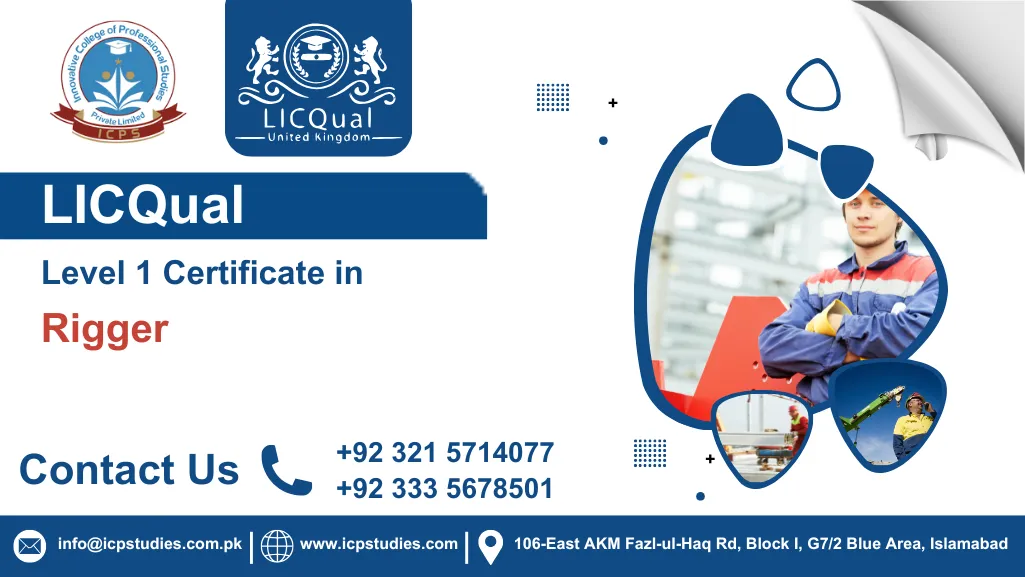The LICQual Level 1 Certificate in Rigger is designed to provide learners with a strong foundation in the essential principles, practices, and responsibilities of rigging operations. This introductory program focuses on equipping participants with the knowledge and practical awareness required to handle rigging tasks safely and effectively in industrial, construction, and engineering environments. Learners will explore the fundamentals of lifting equipment, load handling, safety protocols, and communication techniques, ensuring they gain a clear understanding of the role of a rigger in maintaining workplace safety and operational efficiency. By the end of the course, participants will have developed the confidence to apply basic rigging skills under supervision, while adhering to recognized industry standards.
This certificate is particularly valuable for individuals seeking to begin their careers in rigging or enhance their existing knowledge with a structured qualification. The course emphasizes practical competence, situational awareness, and adherence to safety guidelines, making it suitable for workers in sectors such as oil and gas, construction, shipping, and heavy engineering. Learners will benefit from a curriculum that balances theoretical instruction with applied practice, ensuring they are prepared for real-world rigging challenges. In addition, successful completion of this program can serve as a stepping stone toward further certifications and diplomas in occupational safety, lifting operations, and engineering disciplines, broadening career opportunities and professional recognition.
The LICQual Level 1 Certificate in Rigger introduces participants to the core responsibilities of rigging personnel, including equipment inspection, load securing, and safe lifting practices. The course highlights the importance of teamwork, communication, and compliance with international safety standards, ensuring learners are well-prepared to contribute effectively in demanding work environments. As a foundational certification, it provides a pathway for individuals to progress into advanced training programs and specialized diplomas, reinforcing their professional development and credibility within the industry. This structured approach ensures that learners not only acquire essential rigging skills but also establish a solid base for continuous growth in technical and safety-focused fields.
All About LICQual Level 1 Certificate in Rigger
Course Overview
The LICQual Level 1 Certificate in Rigger provides learners with a structured introduction to the essential skills and responsibilities required in rigging operations. Designed as a foundational program, it emphasizes safe practices, equipment handling, and effective communication within industrial and construction environments. With a clear focus on practical competence, the course ensures that participants gain the necessary awareness to perform rigging tasks under supervision while adhering to recognized safety standards.
This qualification is delivered through a carefully balanced curriculum that combines theoretical knowledge with applied learning. Learners will engage with six comprehensive units, each addressing key aspects of rigging operations, from equipment inspection and load management to teamwork and safety compliance. The program is designed to be accessible to beginners while still offering valuable insights for those already working in related fields. By completing these units, participants will build a strong foundation for professional growth in industries where rigging plays a critical role.
The course carries a total of 12 credits, reflecting the depth and breadth of the learning outcomes achieved. Guided Learning Hours (GLH) amount to 36, ensuring that learners receive sufficient structured instruction and support to develop their skills effectively. This balance of credits and GLH highlights the program’s commitment to delivering quality education in a manageable timeframe, making it suitable for individuals seeking to enhance their employability and workplace competence without extensive time commitments.
The LICQual Level 1 Certificate in Rigger is particularly valuable for those aiming to establish credibility in safety-conscious industries such as oil and gas, construction, shipping, and heavy engineering. By completing this certificate, learners demonstrate their ability to meet industry expectations and contribute to safe, efficient rigging operations. The structured learning pathway, supported by six units and 12 credits, ensures that participants leave the program with both practical skills and theoretical understanding, ready to pursue further certifications and diplomas that expand their expertise and career opportunities.
To enroll in the LICQual Level 1 Certificate in Rigger, learners are expected to meet the following entry requirements:
- Age Requirement: Applicants should be at least 18 years of age to ensure maturity and readiness for workplace responsibilities.
- Educational Background: A basic level of secondary education is recommended. Candidates with prior exposure to technical subjects or related certificates such as Diploma in Occupational Safety, Certificate in Lifting Operations, or Award in Construction Safety will find the course particularly beneficial.
- Language Proficiency: Learners must demonstrate the ability to understand and communicate effectively in English, as course materials, assessments, and instructions are delivered in this language.
- Work Experience: While prior work experience in rigging or construction is not mandatory, individuals with some exposure to industrial or engineering environments may have an advantage in applying the concepts taught.
These requirements are designed to ensure that learners can fully engage with the program and successfully complete the qualification. Meeting these criteria provides a strong foundation for participants to benefit from the training and progress toward further certifications and diplomas in safety, engineering, and lifting operations.
The ideal learner for the LICQual Level 1 Certificate in Rigger is someone who is motivated to build a career in rigging and industrial safety, with a commitment to learning practical skills and applying them responsibly in the workplace.
Professional Mindset
- Demonstrates a strong interest in safety and operational efficiency
- Values teamwork and effective communication in high-risk environments
- Shows discipline and responsibility in following safety protocols
- Seeks to develop credibility in technical and industrial roles
- Maintains a proactive attitude toward learning and skill development
Technical Awareness
- Has a basic understanding of mechanical or engineering concepts
- Shows curiosity about lifting equipment and rigging practices
- Can grasp technical instructions and apply them in practical settings
- Demonstrates problem-solving skills in handling workplace challenges
- Appreciates the importance of precision and accuracy in rigging tasks
Safety Orientation
- Prioritizes personal and team safety in all activities
- Understands the risks associated with lifting and load handling
- Is committed to learning international safety standards and guidelines
- Recognizes the importance of inspections and compliance checks
- Seeks to contribute to a safe and efficient work environment
Learning Approach
- Engages actively with both theoretical and practical training
- Adapts well to structured learning environments
- Demonstrates persistence in mastering new skills
- Values constructive feedback and continuous improvement
- Balances independent study with collaborative learning
Career Aspirations
- Aims to establish a career in rigging, construction, or heavy engineering
- Seeks recognition through certifications and diplomas in safety and technical fields
- Is motivated to progress into supervisory or specialized roles over time
- Values qualifications that enhance employability and professional standing
- Aspires to contribute meaningfully to industrial projects and operations
Personal Attributes
- Displays reliability and consistency in work habits
- Maintains physical fitness suitable for rigging tasks
- Shows adaptability in diverse workplace environments
- Demonstrates respect for cultural and organizational practices
- Upholds integrity and professionalism in all responsibilities
The ideal learner profile ensures that participants not only succeed in the LICQual Level 1 Certificate in Rigger but also build a strong foundation for future growth in technical, safety, and engineering disciplines.
Study Units
- Introduction to Rigging
- Basic Rigging Equipment
- Basic Lifting Techniques
- Health & Safety in Rigging
- Communication and Signaling
- Rigging Operations in the Field
Learning Outcomes
By the end of this course, learners will be able to:
Introduction to Rigging
- Understand the role and importance of rigging across industries such as construction, oil and gas, and shipping.
- Identify and correctly use key rigging terminology and fundamental concepts.
- Recognize various types of rigging operations and explain their practical applications.
- Apply the basic principles of safe rigging practices to reduce risks and prevent accidents.
Basic Rigging Equipment
- Identify essential rigging equipment including slings, shackles, hooks, and pulleys.
- Demonstrate knowledge of the functionality and purpose of different rigging tools.
- Carry out proper inspection procedures to ensure equipment safety and reliability.
- Select appropriate rigging equipment based on load type, weight, and operational requirements.
Basic Lifting Techniques
- Understand the principles of load handling, including balancing, securing, and lifting methods.
- Demonstrate safe lifting and moving techniques to minimize accidents and equipment damage.
- Recognize the importance of load distribution and stability during lifting operations.
- Apply best practices for guiding and controlling loads during lifting and lowering tasks.
Health & Safety in Rigging
- Identify key health and safety regulations and standards relevant to rigging operations.
- Understand the importance of conducting risk assessments and hazard identification.
- Demonstrate correct use of personal protective equipment (PPE) during rigging activities.
- Recognize and manage potential hazards to ensure the safety of both crew and equipment.
Communication and Signaling
- Understand the importance of clear communication and signaling in rigging operations.
- Demonstrate proficiency in using standard hand signals and verbal instructions.
- Recognize the need for concise communication between rigging teams and crane operators.
- Apply correct signaling procedures to maintain safety and coordination during lifting tasks.
Rigging Operations in the Field
- Apply theoretical rigging knowledge in practical, real-world environments.
- Assess site conditions and determine suitable rigging methods for specific tasks.
- Work effectively within a team to complete rigging operations safely and efficiently.
- Adapt rigging techniques to address environmental challenges and complex load requirements.
In conclusion, these learning outcomes ensure that learners completing the LICQual Level 1 Certificate in Rigger gain a solid foundation in rigging principles, equipment handling, safety practices, and teamwork. This prepares them to contribute effectively to workplace operations while maintaining high standards of safety and professionalism.
FAQs About LICQual Level 1 Certificate in Rigger

